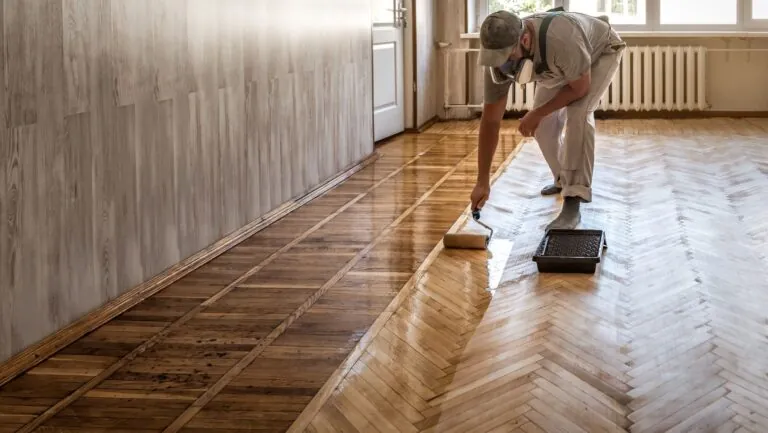When people think about transforming a room, they usually picture the big, obvious changes — a new couch, a fresh coat of paint, or a complete renovation. But in reality, the most dramatic design transformations often come from the unexpected details — the subtle elements that quietly tie everything together.
One of the most overlooked, yet powerful, design elements in any space is the floor. It’s the foundation that everything else rests on — literally — and it has the power to completely alter how a room feels. Whether you realise it or not, your flooring influences the atmosphere, flow, and even the way light behaves in your space.
It’s the design element most people forget about — but once you start paying attention to it, you’ll see just how much it shapes your home’s entire personality.
Table of Contents
ToggleWhy Floors Are the Unsung Heroes of Design
We tend to think of flooring as purely practical: it has to be durable, easy to clean, and long-lasting. But it’s also one of the largest visual surfaces in your home, and that makes it one of the most important design tools you have.
Colour, texture, and sheen all play a huge role in how a space feels. Light floors reflect brightness and make rooms feel more open, while darker tones add warmth and depth. Even the finish — from glossy to matte — can subtly change how your furniture and décor interact with light.
That’s why designers often use finishes like polyurethane floor paints to revive tired floors and create a cohesive aesthetic. These paints not only protect the surface but also allow you to change the tone and texture of your floors without replacing them entirely. A matte finish can make a space feel calm and contemporary, while a semi-gloss coat bounces light beautifully in smaller rooms.
When you think of your floor as a design element rather than just a surface, everything else — furniture, wall colour, lighting — suddenly starts to make more sense.
The Ripple Effect: How Flooring Influences Everything Else
Your floor sets the tone for the entire room. Every colour and material you choose afterwards has to work with it. That’s why mismatched flooring can make even the most beautiful décor feel off-balance.
For example, cool-toned grey floors pair naturally with crisp whites, navy blues, and metallic accents, giving a clean, modern look. In contrast, warm timber tones work beautifully with earthy neutrals, soft greens, and terracotta hues.

The pattern and texture of your flooring also affect visual rhythm. Wide timber planks create a sense of flow, while tiles or chevron patterns add structure and energy. Even rugs — often an afterthought — take their cues from what’s underfoot. A patterned rug can bring personality to a neutral floor, while a plain one can calm down a busy surface.
When your flooring and design palette are in sync, the entire room feels harmonious — like all the pieces finally belong together.
Light, Reflection, and the Psychology of Space
Floors play a crucial role in how light behaves in a room. Lighter surfaces reflect light upward, making the space feel more open and airy. This is especially helpful in smaller rooms or spaces with limited natural light.
On the other hand, darker floors absorb light, grounding the space and creating a cosy, intimate feel. They can make large, open rooms feel warmer and more inviting — perfect for living rooms or bedrooms where you want a sense of comfort.
Even the finish affects perception. Glossy floors act almost like mirrors, amplifying brightness and creating a sense of movement. Matte finishes, by contrast, absorb light for a soft, relaxed feel.
These subtle psychological shifts are why designers pay so much attention to flooring — because it influences how people feel in a room, often without them realising why.
Texture: The Secret Ingredient to Warmth
Colour gets all the credit, but texture is what makes a room come alive. A smooth floor can feel sleek and modern, but too much polish can make a space seem cold. Adding texture — through natural materials or layered finishes — creates depth and warmth.
Think of the visual contrast between polished concrete and woven jute rugs, or matte timber paired with linen furniture. These combinations make a space feel lived-in, tactile, and balanced.
Even within flooring types, texture makes a huge difference. Wire-brushed timber has a rustic charm, while high-gloss tiles scream sophistication. If your room feels flat or sterile, chances are it’s missing texture underfoot.
Colour Continuity: The Trick to Flowing Spaces
If you’ve ever walked through a home where every room feels disconnected, the flooring is probably to blame. Too many colour changes from room to room can make a house feel smaller and more chaotic.
Using a consistent flooring colour (or at least staying within a tonal family) creates visual flow. Your eyes move seamlessly from one area to the next, giving the impression of more space and cohesion.
That doesn’t mean every room has to look identical — you can still create zones with area rugs, furniture placement, or subtle shifts in tone. The key is to keep the underlying base consistent so everything feels intentional.
This principle also applies to open-plan living areas. When your flooring flows uninterrupted across spaces like the kitchen, dining, and lounge, it ties everything together beautifully and makes the area feel expansive.
The Surprising Role of Sheen
While we often focus on colour and material, the level of sheen on your floor can completely change the atmosphere of a room.
- Matte finishes absorb light and hide imperfections, creating a calm, grounded feel — ideal for relaxed, minimal spaces.
- Satin finishes strike a balance between durability and softness, adding a subtle glow without being too reflective.
- High-gloss finishes reflect light dramatically, making rooms look bigger and brighter — but they also show dust and footprints more easily.
Choosing the right sheen depends on how you use the space. For example, matte finishes work beautifully in bedrooms or lounges, while glossier options can bring life to entryways and dining areas.
Reinventing Old Floors
One of the best things about focusing on your floors is that you don’t always need to start from scratch. With the right products and a bit of creativity, you can breathe new life into old surfaces.
Painting timber floors in soft neutrals or pastels creates a modern coastal vibe. Polishing concrete floors can bring industrial chic to contemporary spaces. And using stains or tinted sealers lets you subtly shift the colour of existing wood without losing its natural grain.
For renters or those not ready to commit, rugs can offer a temporary transformation. A large, light-toned rug can make a dark room feel brighter, while layered rugs add instant texture and personality.
The key is to view your floor as a creative canvas rather than just a base layer — a foundation that can evolve as your style does.
The Balance Between Practicality and Beauty
Of course, flooring has to look good — but it also has to work hard. It takes more wear and tear than any other surface in your home. That’s why materials that balance beauty and practicality always stand out.
Timber and engineered wood add timeless warmth, tiles are durable and easy to clean, and modern vinyls offer style with surprising comfort. For busy households, low-maintenance finishes that resist scratches and spills are worth every dollar.
It’s about finding the sweet spot between visual impact and everyday function — a floor that looks stunning but still supports the reality of daily life.
Designing from the Ground Up
When decorating, most people start with paint colours or furniture. But professionals often work the other way around — they design from the floor up. The reasoning is simple: flooring is a long-term commitment, and its tone dictates the direction of everything else.
Once you’ve chosen your floor colour and texture, everything from wall shades to textiles falls naturally into place. A cool-toned floor pairs beautifully with crisp whites and soft greys, while warmer flooring calls for earthy, muted tones.
It’s a perspective shift that simplifies decision-making and ensures every element in your room feels cohesive.
The Power of Subtle Transformations
Sometimes, the most profound design changes aren’t the loudest. Replacing a dated rug, sanding back old timber, or applying a fresh protective coat can instantly lift a room’s energy. It’s not about drastic overhauls — it’s about refining what’s already there.

Your floor quietly influences every other design choice you make — from how your walls appear to how light moves through the space. When you get it right, everything else naturally falls into harmony.
It might be underfoot and often overlooked, but your flooring is the unexpected design element that has the power to transform your home from the ground up — literally.




